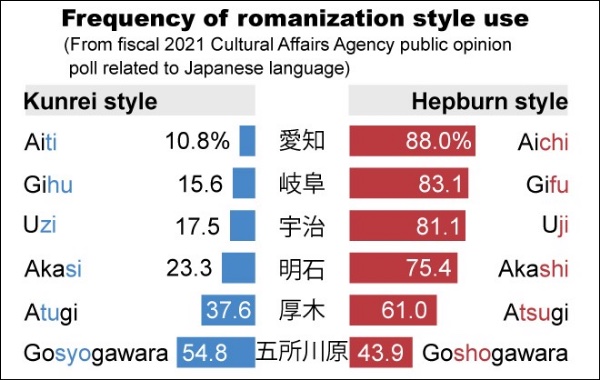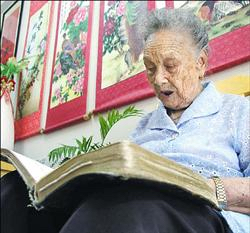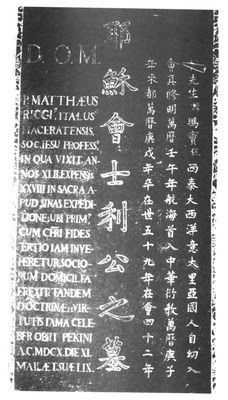Archive for Romanization
November 8, 2022 @ 6:36 pm· Filed by Victor Mair under Romanization, Writing systems
For a country that already has Chinese characters (kanji) and two syllabaries of its own (hiragana and katakana; see also furigana), judging from the ubiquity of romaji across the country, it would appear that they are well into the process of turning Latin letters into an integral component of their quadripartite writing system. Some may argue that they already have done so.
What's going on?
Why hasn't something similar yet happened in China (Vietnam's writing system is already clearly based on the Latin alphabet)?
"Akasi or Akashi? Hepburn Most Established of Japan’s Different 'Rōmaji' Systems", Nippon.com newsletter (11/2/22)
Signs on highways and at railway stations in Japan show place names in both Japanese and Roman letters, although the rōmaji system employed can vary. The Hepburn system dominates, but the Kunrei and Nihon systems are also seen around the country.
Read the rest of this entry »
Permalink
November 7, 2022 @ 6:39 am· Filed by Victor Mair under Dictionaries, Lexicon and lexicography, Romanization
[This is a guest post by Conal Boyce]
Here I’ll deal briefly with Halpern’s Kodansha Kanji Dictionary, then devote most of my attention to the Four‑Corner Method — not that I’m an advocate of the latter but its formal design and quirky byways (such as its Fifth‑Digit Kludge) require a good deal of time simply to be described, never mind assessed. An antiquarian pursuit? Given that translation apps now have a phone‑camera option for handling hànzì, and given that a Chinese Chip in the cranium seems imminent, a study of two dictionary look‑up methods might strike one as quaint. But there are lessons to be learned by studying such material as if from a System Analyst’s viewpoint. I hope this piece might have some appeal from that angle at least, if not from a nuts‑and‑bolts Chinese studies standpoint.
Read the rest of this entry »
Permalink
October 2, 2022 @ 12:56 pm· Filed by Victor Mair under Orthography, Romanization
All Japanese individuals who have attended elementary school since WW II have been taught to read and write romanized Japanese, and romanization is widely used for computer inputting and for other specialized purposes, particularly for those involving foreigners who do not know kana and kanji, but by no means for everyday reading and writing by Japanese citizens. There are numerous different schemes for the romanization of Japanese, but the three main ones are: Hepburn, Kunrei-shiki, and Nihon-shiki. More about each of them below, but first a rough comparison of the two leading systems:

From Momoko Jingu, "Cultural agency now weighing romanization of Japanese words", The Asahi Shimbun (10/1/22).
Read the rest of this entry »
Permalink
September 26, 2022 @ 8:52 am· Filed by Victor Mair under Idioms, Language and biology, Language and literature, Language and psychology, Romanization, Tones
That's the name of a treasured Language Log reader and contributor (see under "Selected Readings"). When I asked him how to write that in Sinoglyphs, he told me that it is this:
飢腸轆轆 / simpl. 饥肠辘辘
Wanting to get the tones, I typed "jichanglulu" into Google Translate (GT), but forgot to click the space bar to make the conversion to characters with Hanyu Pinyin transcription complete with tones. When I pressed the speaker button to hear how that sounded, what came out was something like Mandarin with an English accent, but still perfectly intelligible: "jichanglulu". It resembled the Mandarin produced by the strangers on the street who read off the Pinyin texts handed to them by my wife, Li-ching Chang. She was always delighted when she heard them pronouncing Mandarin without ever having studied it. "Jichanglulu" — see, you can say it too!
Adding the tones, we get jīcháng lùlù. What does this somewhat odd assortment of sounds signify?
GT says "hungry", more literally, "hungry intestines are rumbling".
Read the rest of this entry »
Permalink
July 17, 2022 @ 8:32 pm· Filed by Victor Mair under Alphabets, Romanization, Signs
Diana Zhang was in Lima, Peru last week, and this is what she saw:

Read the rest of this entry »
Permalink
April 22, 2022 @ 12:40 am· Filed by Victor Mair under Alphabets, Language teaching and learning, Romanization, Writing systems
Referring to the first post in this series, "Hokkien at UCLA" (4/20/22), Chau Wu writes:
I totally agree with you about the Chinese prerequisite.
When I was younger (no, a lot younger) back in Taiwan, I had known a few grandmotherly Christian ladies who were illiterate in Sinitic script but perfectly at home in reading the Taiwanese Bible in Pe̍h-ōe-jī (POJ), i.e., Church Romanization (see below at * for further discussion). The following pictures appeared in the Taiwanese newspaper 自由時報 (Liberty Times) (Hokkien POJ Chū-iû-sî-pò; Hanyu Pinyin Zìyóu Shíbào) a few years ago about a Mrs. Lin (unrelated to any of the ladies I knew of) reading the Bible (Note the Bible shows signs of having been heavily used):

Read the rest of this entry »
Permalink
April 20, 2022 @ 11:00 pm· Filed by Victor Mair under Language extinction, Language teaching and learning, Romanization, Topolects
Article in Taiwan News:
"UCLA students learn about Taiwanese Hokkien in MOE*-supported course:
Course examines Taiwan’s widely-spoken dialect ‘in different forms of cultural production’", By Stephanie Chiang (4/19/22)
*Ministry of Education
UCLA began offering its first Taiwanese Hokkien course in January 2020:
The description of the course entitled “Taiwanese Language and Culture” reads, “Taiyu, or Taiwanese (also known as Minnan, Hoklo, or Hokkien, depending on context or region), is the language that most Taiwanese people use in daily lives, including everyday interaction and communication, entertainment, social and cultural events, etc.” The four-unit course offered to upper-division students requires students to have taken at least a year of Chinese courses or a Chinese placement test showing equivalent knowledge.
I wish they didn't have the prerequisite mentioned in the last sentence and don't understand the reason for such a requirement.
Read the rest of this entry »
Permalink
December 21, 2021 @ 10:41 pm· Filed by Victor Mair under Alphabets, Romanization, Spelling, Topolects
Tweet from Alan DAI:
[Click on the photograph to see the complete Twitter thread, which has additional illustrations of printed Latinxua texts.]
Read the rest of this entry »
Permalink
November 24, 2021 @ 6:45 am· Filed by Victor Mair under Language and religion, Romanization, Writing systems
Epigraph on the Tombstone of Matteo Ricci in the Zhalan Cemetery in Beijing:

Inscription on the tomb of Matteo Ricci (1552–1610), black-and-white photograph, unknown photographer; source: with the kind permission of the Ricci Institute, University of San Francisco.
Read the rest of this entry »
Permalink
October 31, 2021 @ 1:26 pm· Filed by Victor Mair under Language and computers, Romanization, Typing
The following is a guest post by Mingfei Lau. A short intro about the author:
My name is Mingfei Lau, a member of The Linguistic Society of Hong Kong Jyutping Workgroup. I am a language engineer at Amazon and I work on different projects on Cantonese resource development in my spare time.
Today, Pinyin is undoubtedly the most popular way to type Mandarin. But what about Cantonese? This wasn’t easy until rime-cantonese, the normalized Cantonese Jyutping[1] lexicon appeared. Lo and behold, you can now type Cantonese in Jyutping just like typing Mandarin in Pinyin.

Read the rest of this entry »
Permalink
October 14, 2021 @ 5:09 pm· Filed by Victor Mair under Language and literature, Language and music, Romanization, Topolects
Usually, though not always, when I Romanize Sinographs on Language Log, I do so using Modern Standard Mandarin (MSM), but that is misleading, because MSM is only one of countless different topolectal pronunciations that could be used (Cantonese, Shanghainese, Sichuanese, and so on and so forth). MSM is particularly ill-suited for the Romanization of pre-modern literature, since — of all topolects — it is the most highly evolved (ergo youngest) and least like earlier stages of Sinitic. In this post, I will use Southern Min pronunciation to give a sense of how different it is from MSM.
The Min Romanizations have been prepared by Conal Boyce using a Yale-like system he developed in 1975 in preference to Douglas-Campbell.
Douglas, Carstairs (1899) [1873]. Chinese-English Dictionary of the Vernacular or Spoken Language of Amoy (2nd ed.). London: Presbyterian Church of England.
Campbell, W. (1913). A Dictionary of the Amoy Vernacular. Tainan: Ho Tai Tong.
Read the rest of this entry »
Permalink
September 27, 2021 @ 7:18 am· Filed by Victor Mair under Language and literature, Language and politics, Romanization
Meng Wanzhou 孟晚舟 is the Chief Financial Officer of Huawei (the PRC communications technology giant), who was arrested on financial fraud charges at Vancouver International Airport on December 1, 2018. Nearly three years later, in exchange for two Canadian citizens (the "two Michaels", Michael Kovrig and Michael Spavor, who had been summarily taken prisoner and held in Chinese jails for 1,020 days), she was released from detention and flew back to China on September 24, 2021. The text quoted below was supposedly written by her on the flight from Canada to China.
Also provided is a photograph of people gathered in the Shenzhen airport to welcome her with red banners, two of which have Hanyu Pinyin phonetic annotations on them.
Questions have been raised about the nature and quality of the essay attributed to Meng.
Read the rest of this entry »
Permalink
September 10, 2021 @ 4:38 am· Filed by Victor Mair under Announcements, Language and gender, Language and politics, Phonetics and phonology, Romanization, Topolects
New issue of Sino-Platonic Papers (no. 317 [August, 2021]):
“'Kong Girl Phonetics': Loose Cantonese Romanization in the 2019 Hong Kong Protest Movement,” by Ruth Wetters (free pdf)
Abstract
Cantonese in Hong Kong occupies a specific cultural and political niche, informed by the unique context of the Hong Kong identity. During the 2019 Hong Kong protests, protesters used modified Cantonese online to evade detection and cement their identity as Hong Kongers. One way in which this was achieved is through a new online vernacular, dubbed “Kong girl phonetics” Kong nui ping jam. This vernacular borrows from grassroots romanization, English phonetics, number substitutions, and bilingualism in English and Cantonese to exclude all readers except young Hong Kong people, who show high bilingualism and high tech literacy and share the vocabulary of protesters. This essay explores aspects of this protest vernacular through non-comprehensive analysis of a thread on LIHKG (Lineage: Hong Kong Golden) lin dang 連黨 that is the first recorded example of “Kong girl speech.”
Read the rest of this entry »
Permalink




